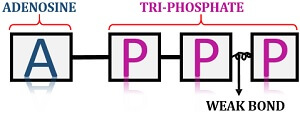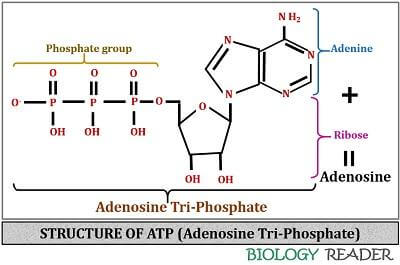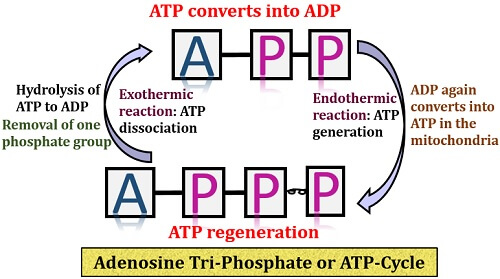Adenosine Tri-phosphate is an organic compound that is considered as the coin of energy, which gives energy for many cellular processes. It is a nucleoside triphosphate, which contains adenine (a nitrogenous base), a ribose sugar and three phosphate groups. ATP is a type of chemical energy, which produces energy by the breakdown of one phosphate group.
The release of phosphate group gives chemical energy to the cells for their proper functioning and metabolism. ATP is a high energy molecule because of the highly electronegative phosphodiester bond between the phosphate groups that hold a significant amount of energy.
The hydrolysis of ATP not only provides energy to the cells but also helps in cell signalling. Most of the ATP is synthesized during the cellular respiration and consumed during the substrate phosphorylation, ion transport etc. In this context, we will discuss the meaning, features, structure of the adenosine triphosphate along with the steps in the ATP cycle.
Content: Adenosine Tri-phosphate
Meaning of Adenosine Tri-phosphate
Adenosine triphosphate is an organic molecule, which acts as a fuel for the living cells to carry out many biological and biochemical processes where it releases energy by the breakdown of a highly electronegative phosphodiester bond between the second and third phosphate group. Thus, the breakdown of one phosphate group from the ATP is the process called ATP hydrolysis. Its hydrolysis results in the ADP formation and release of one phosphate group.

History
Some contributors notably gave their contribution to the discovery of ATP as an energy molecule.
| Scientists | Discovery | Won Nobel prize in the year | Won Nobel prize in the subject |
|---|---|---|---|
| Fritz Lipmann | Discovered process by which the cells can convert basic elements of food into energy. | 1953 | Physiology and medicine |
| Peter Dennis | Discovered process by which the cells can generate a molecule of ATP as an intermediate source of energy. | 1978 | Chemistry |
| Edmond H. Fischer | Demonstrated how cells can breakdown sugar in the bloodstream for use as fuel | 1992 | Physiology and medicine |
| Edwin Krebs | Demonstrated process by which cells can breakdown glycogen in the bloodstream and burn it as a fuel. | 1992 | Physiology and medicine |
Features of ATP
-
- ATP stands for Adenosine triphosphate.
- The structure of the ATP molecule consists of adenine molecule, a ribose sugar and three phosphate groups.
- ATP acts as the battery, which gives power to the living cells to perform certain biological and biochemical functions.
- Adenosine triphosphate is a molecule, which forms by the degradation of organic macromolecules like proteins, nucleotides etc. through the catabolic process.
- ATP gives energy to all type of organisms.
- In a plant cell, ATP forms in the thylakoid membrane or the chloroplast of the cell.
- In the animal cell, ATP formation occurs in the powerhouse of the cell called mitochondria.
- ATP-synthase is the enzyme that helps in the ATP-synthesis.
- The chemical formula of ATP is C10 H6 N5 O13 P3.
- ATP has a 507.18 g/mol of molecular weight.
- The density of the ATP molecule is 1.04 g/cm3
Adenosine Tri-phosphate Structure
The structure of ATP possesses three elements, namely adenosine, a ribose sugar and three phosphate groups.

Adenosine: Adenosine comprises of adenine and ribose sugar. Adenine is the nitrogenous base, which contains a nitrogen atom in its structure as a backbone and ribose is the pentose sugar. Therefore, both adenine and ribose combine to form a nucleoside called “Adenosine”. In adenosine, adenine binds with the ribose sugar via β-N9 glycosidic-bond.
Basically, there are three derivatives of adenosine viz. AMP (Adenosine Monophosphate), ADP (Adenosine Di-phosphate) and ATP (Adenosine Tri-phosphate). Among these three derivatives, the ATP molecule is a high energy-producing molecule for all the living organisms. Adenosine itself acts as a neuromodulator and performs the following tasks:
- Promotes sleep
- Suppresses arousal
- Helps in the regulation of blood flow
Ribose: It is the pentose sugar or 5-C sugar, which has a chemical formula C5H10O5. Ribose merely refers to the aldopentose sugar that is the monosaccharide, which contains 5-carbon atoms and a functional group (aldehyde) at one end.
Phosphate group: Phosphate molecule consists of one phosphorus and four oxygen atoms and has the chemical formula PO43-. When the phosphate molecule attaches to the carbon-containing molecule, then it is called a phosphate group.
ATP-Cycle Steps
Adenosine Tri-phosphate-cycle is defined as the continuous process, where the energy-releasing molecule, i.e. ATP, is continuously dissociated and generated in all the living organisms.

ATP- Dissociation
![]()
It merely refers to the breakdown of ATP-molecule. It is an exothermic process, in which the energy is released by the cell in the form of ATP. The ATP molecule is converted into ADP by the chemical change in its configuration.
The Adenosine Tri-phosphate releases energy for the functioning of a cell by the breakdown in a chemical bond, or we can say by the breakdown of a phosphate group. This phosphate group then acts as an energy source for the cells to do work.
ATP- Generation
![]()
ATP- generation is the endothermic process, in which the ADP molecule is again converted into high energy-producing molecule ATP. Here, the energy is absorbed by the cell. The ATPs is generated through the cellular respiration by an enzyme called ATP-synthase.